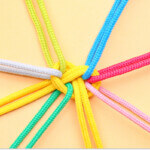You’re being creative all the time, whether you realize it or not. You don’t need to dash off a sonnet at lunchtime or take up painting to enhance your creativity.
From cooking dinner to choosing an outfit, many things you’re already doing as part of your routine are creative flywheels. Here are 5 daily activities that can stretch and strengthen your creative muscles.
1. Choosing What to Wear
Whether it’s your go-to outfit or whatever’s clean, deciding what to wear is often a missed opportunity for a bit of creative expression.
Creativity is all about taking existing ideas and connecting them in fresh ways. Exploring your wardrobe and combining colours and articles in new ways, is about as literal as an approach to remixing as it gets.
What you choose to wear influences your thoughts during the day. Simply wearing a lab coat can make you feel smarter. Wearing red can help you lift heavier weights (vs blue). A study found that people who “dressed up” showed greater levels of abstract thinking commonly linked to creativity.
And this isn’t only about self-perception. In one study, wearing red sneakers improved the perceived competence of a professor.
As an experiment, note how you felt or how people around you engaged with you when you wore certain things. It might make you rethink casual Friday (if there’s still such a thing) or lounging around the house wearing sweats all day.
Why It Works: Picking out a fresh outfit helps you physically engage with the creative concept of linking existing ideas together in new ways. Clothing influences the way you think, helping you feel more creative throughout the day. It also influences the way others perceive you – for both the negative and positive.
2. Gardening
Gardening might not seem very creative at first glance – it’s the plants doing the growing, after all. Right?
However, the imagination, planning, attentiveness, and technique required for gardening closely mirror the efforts that go into a creative or artistic project. You start out with a vision, work through the practicalities, gather your materials, and work to turn it into a reality.
Geoff Hamilton, a horticulturist and broadcaster, spent his career trying to make gardening more accessible to everyone. He said that through the use of thought, patience, and creativity in gardening we “all use our nascent creative talents to make a truly satisfying work of art”.
You don’t need a full-blown garden. Window flower boxes work great. Or a glass jar and a few other inexpensive materials to build yourself a terrarium – your very own creativity micro-engine.
Why it Works: Gardening is a great exercise in decision-making and planning. The slow pace and regular tasks also help you to appreciate the importance of technique, patience, and persistence when it comes to making something worthwhile. Not to mention that nature is a powerful conduit for creative thinking.
3. Cooking Something New
Perhaps one of the easiest ways to experiment with creativity is by trying a new recipe for dinner. Even if you’re following recipe directions, you’ll still get the thrill of creating something or learning a new skill. All the while, discovering the relationships between flavors.
For an even more creative challenge, pick a recipe you’re already familiar with and put your own spin on it. Get playful with it and don’t overthink it at first – it could be as simple as swapping out one ingredient for another.
Whatever the outcome, you’ve injected a little bit of creative exploration. And even better, you’ll be able to build on what you learned. As with gardening, cooking gives you a greater appreciation for the power of process when it comes to creating something from nothing.
Why It Works: Cooking helps you to get more comfortable with experimentation and the possibility of failure, two things that are a natural and valuable part of creativity.
4. Rearranging Your Space
Interior design undoubtedly involves a lot of creativity. Regularly investing in new furniture and décor as a creative outlet isn’t pragmatic. You can, however, benefit without spending any money by simply rearranging the items you already have.
The process is creative in itself as it allows you to reimagine your space. It could also help spur you on to further creative thinking by introducing change into your environment.
Psychologist Robert Epstein explains: “The enemy (of creativity) is whatever is static. So just making changes sometimes, very small changes, can make a huge difference.”
The type of changes you make can also be important. If something (such as a particular type of architecture or a country you’ve visited) excites you, brings you joy, or leaves you feeling inspired, see how you can recreate and integrate that in your space.
Whether it’s an entire room, or the objects on your desk, incorporating things that inspire you, even in tiny ways, can make an impact. Displaying mementos from your travels, inviting the outdoors in using natural materials, or changing the layout of the room can reinforce positive associations.
Why it Works: Tweaking your space helps you see things in a new light and keep things fresh. Even a small change to the status quo can inspire creative ideas.
5. Using Pen and Paper
When was the last time you took notes by hand? Using a pen and paper is a great way to encourage your brain to think more creatively and change your perspective.
John Long, Group Creative Director for Ogilvy and Mather, covered the creative benefits of pen and paper for The Drum. He wrote that the practice removes the familiarity of standard layouts, templates, and fonts, disrupting your thought process so you don’t default to your usual way of thinking about a task. “A blank piece of paper simply doesn’t have all that baggage.”
Research suggests that writing by hand might also provide other neurological benefits, as it appears to engage areas of the brain in ways that typing doesn’t.
Handwriting forces you to slow down, really focusing on the present and thoughts as they occur to you. Additionally, the lack of ctrl-z means you can’t self-sensor your ideas. An unrestrained thought process, however messy, can give you fresh insights.
Doodling on paper also has cognitive and emotional benefits. Doodling is a way of creating without the pressure of a particular goal weighing you down and can help you keep track of ideas. Researcher Giulia Forsythe explained: “Doodling is a form of external thought that allows you to visualize the connections you are making while thinking.”
Why it Works: Writing on paper encourages your brain to work in more creative ways. Paper also represents far more freedom and possibility than a screen with standardized fonts and formatting.
Being Creative Whenever, Wherever, and However
Creativity is everywhere. By learning to recognize, celebrate, and build on the creative process that goes into daily activities, you can nurture the quality of your creative output.
By being more intentional about creative acts, you’ll become far more comfortable with the key elements of the creative process, such as patience, experimentation, problem-solving, and imagination. And in the process, you’ll get to enjoy the benefits of thinking more creatively.
The more you exercise your creativity, the easier it gets to think creatively.




